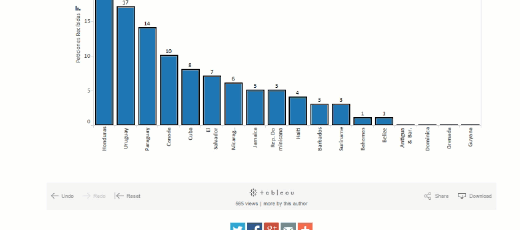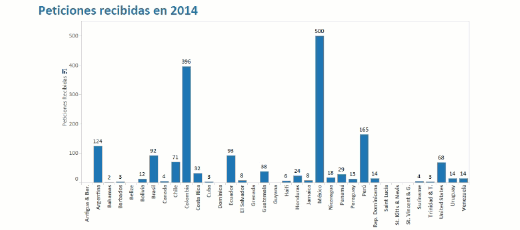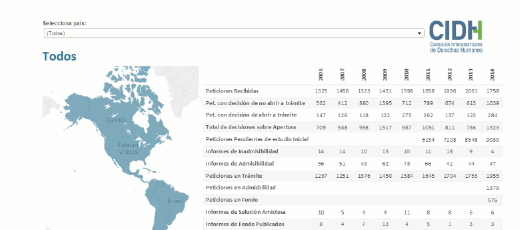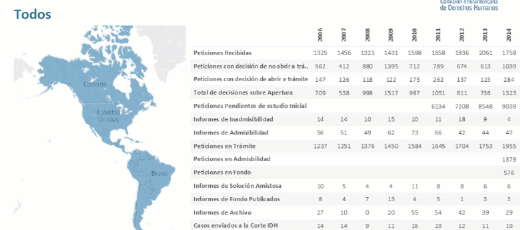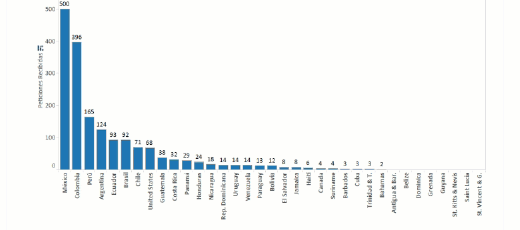Petitions
A petition is a complaint filed with the IACHR alleging violations of human rights. Once an Admissibility Report has been adopted, the petition becomes a case.
Petitions Received
The line in the charts and graphs called “Petitions Received” shows the number of petitions the IACHR received during the entire year, through December 31 of each year.
Initial Review
During the initial review stage, the petition is examined to see whether it meets the requirements established in Article 28 of the IACHR Rules of Procedure, taking into account only the information provided by the petitioner. Given the large number of petitions the IACHR receives, the preliminary evaluation of a petition may take some time.
Decisions on Whether to Process
The initial review period ends with a decision as to whether or not a petition received by the IACHR will be opened for processing. The decision of whether or not to process the petition is notified to the petitioning party.
Petition Opened for Processing
A petition is opened for processing when it is decided during the initial review, based on the information provided by the petitioning party, that the petition meets the requirements established in Articles 26 and thereafter of the IACHR Rules of Procedure. Once the decision to open a petition for processing is made, the petitioning party is notified, as is the State against which the complaint has been filed. At that time, the petition enters the admissibility stage.
Petitions with Decision to Process
The line in the charts and graphs called “Petitions with Decision to Process” shows the number of petitions the IACHR decided to open for processing between January 1 and December 31 of that year. This is the number of petitions that moved from the initial review stage to the admissibility stage.
Petition Not Opened for Processing
When a petition, in accordance with the information presented by the petitioner, does not meet the requirements established in Article 28 of the Commission’s Rules of Procedure, a decision is made not to open it for processing. This decision means that the necessary requirements were not met for the Commission to examine the petition, but it does not indicate any decision with respect to the material presented.
Petitions with Decision Not to Process
The line in the charts and graphs called “Petitions with Decision Not to Process” shows the number of petitions the IACHR decided not to open for processing between January 1 and December 31 of that year.
Total Decisions on Whether to Process
The line in the charts and graphs called “Total Decisions on Whether to Process” shows the total number of petitions for which a decision was made that year, whether a decision to open or not to open for processing.
Admissibility Stage
The admissibility stage begins when a decision is adopted to open a petition for processing and the decision is sent to the State against which the complaint has been filed and to the petitioner, with a request to the State that it submit its observations. During the admissibility stage, the IACHR studies the information submitted by both parties to decide whether the petition is admissible or inadmissible. The Commission may request additional information from both parties. Any information submitted by one party is forwarded to the other party so that it may submit responses, arguments, and information. After this exchange of information, the Commission must decide whether the petition is admissible or inadmissible, in other words whether it meets the admissibility requirements set forth in Articles 46 and 47 of the American Convention on Human Rights, in accordance with the procedure established in Articles 30 to 36 of the Commission’s Rules of Procedure. Processing at this stage begins with the transmittal of the petition to the State and concludes with a decision issued by the IACHR in an Admissibility Report or an Inadmissibility Report, which is notified to both parties.
Petitions at the Admissibility Stage
The line in the charts and graphs called “Petitions at the Admissibility Stage” shows the number of petitions at the admissibility stage, through December 31 of each year. These petitions are still under a rule of confidentiality, and the IACHR’s communications concerning them take place only with the parties. The IACHR began to make public the number of petitions in the admissibility stage in 2014, so this line does not include information on previous years.
Admissibility or Inadmissibility Reports
These are reports that are approved at the end of the admissibility stage, either Admissibility Reports or Inadmissibility Reports. They are public, so they are posted on the IACHR website. If an Admissibility Report is approved, the petition becomes a case and it is assigned a case number and enters the merits stage. If an Inadmissibility Report is approved, the processing of the petition ends at that time. In the charts and graphs, “Admissibility Reports” shows the total number of Admissibility Reports approved between January 1 and December 31 of that year, and the line “Inadmissibility Reports” shows the number of Inadmissibility Reports approved in that same period.
Cases
“Cases” are understood to be all petitions that have been declared admissible by means of an Admissibility Report. Under previous Rules of Procedure, a case number was assigned to petitions that did not yet have an Admissibility Report.
Merits Stage
The merits stage is where the IACHR must decide on the merits or substance of the matter, that is, whether or not there were violations of human rights in the case being analyzed. This determination is made based on the information submitted by the State and the petitioner. The Commission may request additional information from both parties, and it forwards everything it receives from one party to the other party. The procedure on the merits is regulated in Articles 48 and 50 of the American Convention on Human Rights and Articles 37, 38, 39, 43, and 44 of the Commission’s Rules of Procedure. The merits stage begins when an Admissibility Report is approved and the parties notified, which is when a case number is assigned.
Cases at the Merits Stage
The line in the charts and graphs called “Cases at the Merits Stage” shows the number of such cases through December 31 of each year. The processing of the cases is confidential, and the IACHR’s communications concerning these cases take place only with the parties. In general, cases at the merits stage have an Admissibility Report that is public and can be found on the Commission’s website, except when a decision has been made to decide jointly on admissibility and the merits. The IACHR began to make public the number of cases at the merits stage in 2014, so this line does not include information about previous years.
Merits Report
The merits stage ends with the approval of a Merits Report, which contains the conclusions about whether the facts of the case constitute human rights violations. If it is found that there were human rights violations, the Merits Report includes recommendations to the State, which may be designed to: bring an end to the actions that violate human rights; clarify the facts and carry out an investigation and punishment; make reparation for the damages caused; introduce changes to the legal system; and/or require the adoption of other measures or State actions to prevent similar violations from occurring in the future.
Merits Report Approved
The line in the charts and graphs called “Merits Reports Approved” shows the number of Merits Reports the Commission approved that year, which is different from the number of Merits Reports published. When a Merits Report is approved, in accordance with Article 50 of the American Convention on Human Rights, it is confidential, and the Commission notifies only the parties (the State and the petitioner). Merits Reports that have been approved can be published later if the Commission so decides, pursuant to Article 51(3) of the American Convention on Human Rights. If the Commission decides to send a case to the Inter-American Court, the Merits Report on that case will be published on the IACHR website, under Cases in the Court.
Merits Report Published
The line in the charts and graphs called “Merits Reports Published” shows the number of Merits Reports the Inter-American Commission decided to publish, pursuant to Article 47.3 of its Rules of Procedure or Article 51(3) of the American Convention on Human Rights. This line does not include the Merits Reports on cases submitted to the Inter-American Court, although those are published on the IACHR website, under Cases in the Court.
Pending Petitions and Cases
Pending petitions and cases are all those for which there has already been a decision to open for processing—that is, all petitions at the admissibility stage and all cases at the merits stage, as well as those petitions and/or cases in which the parties are willing to reach a friendly settlement.
Friendly Settlements
This is a process that depends on the wishes of the parties and consists of negotiations aimed at resolving the matter without the need to reach a conclusion on the matter in dispute. The process unfolds under the Commission’s supervision. Read more in the thematic report “Impact of the Friendly Settlement Procedure.”
Friendly Settlement Report
When the State and the petitioning party of a petition or case resolve the matter through a friendly settlement and sign agreements, the IACHR monitors compliance with the points that were agreed upon. When there has been compliance with all or most of the substantive points agreed upon between the parties, the IACHR approves and publishes a Friendly Settlement Report, which ends the processing of the case. This line in the charts and graphs shows the number of Friendly Settlement Reports approved by the IACHR between January 1 and December 31 of each year.
Archive Decisions
This line in the charts and graphs shows the number of decisions approved by the IACHR between January 1 and December 31 of each year. These are public and are posted on the IACHR website. The Commission may decide to archive a file at any time in the proceedings, if the grounds for the petition or case do not exist or no longer exist, or if the information necessary to reach a decision is unavailable. The conditions for archiving a case are established in Article 48.1(b) of the American Convention on Human Rights and Article 42.1 of the IACHR Rules of Procedure. Beginning in 2015, the IACHR changed its decision-making methodology for archiving a case, and this is no longer done by means of a report.
Cases Sent to the Inter-American Court of Human Rights
When a State fails to comply with the recommendations contained in a Merits Report and that State has recognized the Inter-American Court’s jurisdiction, the Commission may decide to take the case to the Inter-American Court. The Commission may refer cases to the Inter-American Court only with respect to those States that have ratified the American Convention and have recognized the Inter-American Court’s jurisdiction, or when a State accepts jurisdiction expressly for a specific case.
Precautionary Measure
In serious and urgent situations, the Commission may request that a State adopt precautionary measures to prevent irreparable harm to persons or to the subject matter of the proceedings in connection with a pending petition or case, and also to protect persons from irreparable harm, whether or not there is a related petition or case pending before the IACHR. The procedure for the precautionary measure mechanism is established in Article 25 of the IACHR Rules of Procedure. As established in the Rules of Procedure, the Commission may request that a State adopt precautionary measures on its own initiative or at the request of a party.
Requests for Precautionary Measures
The line in the charts and graphs called “Requests for Precautionary Measures” or “Requests Received for Precautionary Measures” shows the number of requests for precautionary measures submitted to the IACHR between January 1 and December 31 each year. After examining a request for precautionary measures, the Commission may adopt a decision to grant or not to grant such a measure, request additional information from the person or persons or the organization making the request, request information from the State involved, or request information from both parties. If information is requested from one or both parties, another analysis is done which could result in a decision to grant or not to grant a precautionary measure or to request additional information.
Precautionary Measures Granted
The line in the charts and graphs called “Precautionary Measures Granted” reports the number of precautionary measures the IACHR decided to grant between January 1 and December 31 of each year. The decision to grant a precautionary measure (that is, to request that the State adopt urgent measures) is adopted when the Commission finds that the requirements established in Article 25 of its Rules of Procedures are in place, in terms of a serious, urgent situation in which there is an imminent risk of irreparable harm to a person or group of persons.

